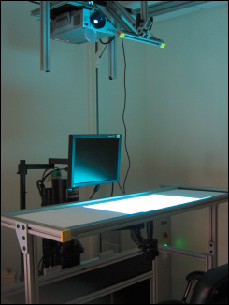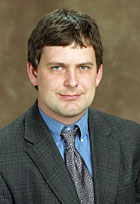Central to being human is the ability to adapt: We learn from our mistakes. Previous theories of learning have assumed that the size of learning naturally scales with the size of the mistake. But now biomedical engineers at Washington University in St. Louis have shown that people can use alternative strategies: Learning does not necessarily scale proportionally with error.
In so doing, Kurt Thoroughman, Ph.D., assistant professor of biomedical engineering at Washington University, and his graduate student, Michael Fine, have discovered a new learning strategy they call categorical adaptation in which steps of learning are sensitive to the direction of error, but do not scale proportionally with the size of the error. Eventually, their findings could have an impact in the rehabilitation of people with neurological ailments such as strokes by making use of different learning environments.

If you make a movement error in one direction, in makes sense that your next movement would correct toward the opposite direction, in exact proportion to the error. An example would be a pitcher correcting to the right, after missing home plate to the left with a pitch.
“We show that learning does not necessarily scale with error,” said Thoroughman. “I think we have uncovered a part of human adaptation that certainly doesn’t do that. We are not claiming that all previous theories are false in the behaviors that were captured. It’s just that we have for the first time found a part of human adaptation that clearly does not scale with the size of the error.”
Thoroughman is interested in how humans learn motor skills incrementally, how information from a single movement can inform the generation of the next movement. He and Fine asked volunteers to make reaching movements while holding the end of a robotic arm. Volunteers were trained for about 40 minutes a day for two days. On each day, subjects were asked to make half-second, 10-centimeter reaching movements, directed away from their bodies.
Subjects learned the baseline task on the first day. On the second day Thoroughman and Fine tricked volunteers by having the robotic arm push the human hand with a perturbing pulse of force in 20 percent of movements. The pulse pushed subjects from their normal trajectory, either to the right or the left, with three different pulse strengths. Thoroughman and Fine observed how the pulse altered that trajectory and how subjects corrected, or adapted, in the very next movement.

“The pulse should induce an error in that movement that scales with the size of the pulse,” said Thoroughman, who also has appointments in Neurobiology and Physical Therapy at the Washington University School of Medicine. “And we did see that – big pulse, big error; small pulse, small error. But then we expected, just as previous theories would predict, that the adaptation in the next movement would also scale with the size of the force pulse. But it didn’t – the adaptation countered the direction of the pulse but was flat with respect to the size of the pulse.”
The results were published in the August 2006 issue of the Journal of Neurophysiology.
Thoroughman said the discovery raises interesting new questions in motor learning and neurophysiology and eventually could have an impact on physical therapy protocols.
“By changing environments in a specific way and by not providing the same environment all of the time, we can change the way that people learn,” he said. “We’re hopeful that this kind of technology can help in neurological rehabilitation so that stroke patients, for instance, could better relearn movements and reduce recovery time.”